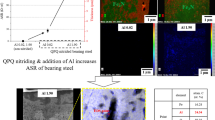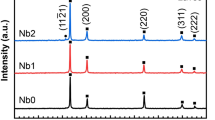Abstract
In acid sulfate solutions, the electrochemical behavior of steel ShKh15 quenched at a high ductile–brittle transition temperature (1100–1300°C) is largely defined by the content of impurities (Cr, Si, S, P) at grain boundaries, which depends on the quenching temperature. The cathodic-reaction order by hydrogen ions decreases and the anodic-reaction order by hydroxyl ions increases with increasing the content.
Similar content being viewed by others
REFERENCES
Zabil'skii, V.V. and Nikonova, R.M., Metalloved. Term. Obrab. Met., 1999, no. 6, p. 19.
Zabil'skii, V.V., Nikonova, R.M., and Makletsov, V.G., Materialovedenie, 1999, no. 8, p. 7.
Karshulin, M., Delset-Kovach, I., and Stupichek, E., Elektrokhimiya, 1977, vol. 13, p. 690.
Becelli, L.P. and Pomagnani, C., J. Chim. Phys. Phys.-Chim. Biol., 1975, vol. 72, p. 327.
Kolotyrkin, Ya.M. and Florianovich, G.M., Zashch. Met., 1965, vol. 1, p. 7.
Vigdorovich, V.I. and Tsigankova, L.E., Elektrokhimiya, 1976, vol. 12, p. 1430.
Kanunnikova, O.M. and Gil'mutdinov, F.Z., Izv. Akad. Nauk, Neorg. Mater., 1996, vol. 32, p. 120.
Author information
Authors and Affiliations
Rights and permissions
About this article
Cite this article
Makletsov, V.G., Zabil'skii, V.V., Nikonova, R.M. et al. Electrochemical Behavior of Steel ShKh15 in Acid Sulfate Solutions as a Function of the Quenching Temperature. Russian Journal of Electrochemistry 37, 330–332 (2001). https://doi.org/10.1023/A:1009050019267
Issue Date:
DOI: https://doi.org/10.1023/A:1009050019267




